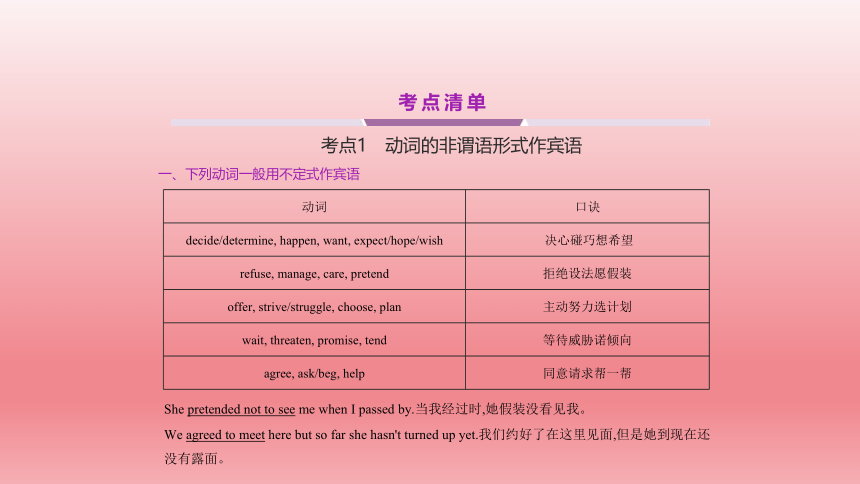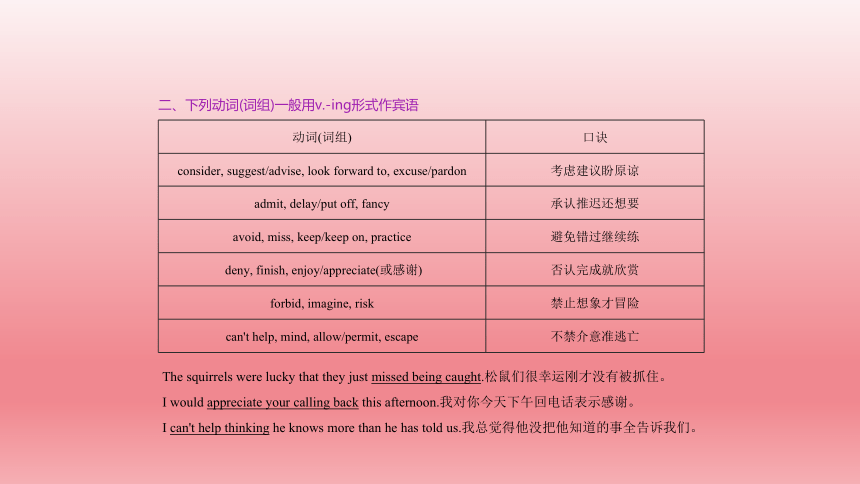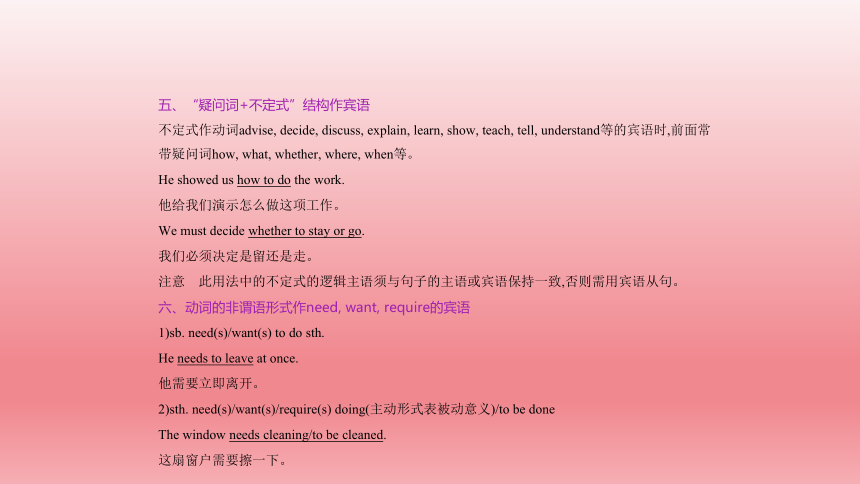2024届高考英语复习专题:动词的非谓语形式课件(共29张PPT)
文档属性
| 名称 | 2024届高考英语复习专题:动词的非谓语形式课件(共29张PPT) |  | |
| 格式 | pptx | ||
| 文件大小 | 709.0KB | ||
| 资源类型 | 教案 | ||
| 版本资源 | 通用版 | ||
| 科目 | 英语 | ||
| 更新时间 | 2023-12-19 08:48:52 | ||
图片预览









文档简介
(共29张PPT)
2024届高考英语复习专题★★ 动词的非谓语形式
2024届高考英语复习专题★★
考点1 动词的非谓语形式作宾语
一、下列动词一般用不定式作宾语
考点清单
动词 口诀
decide/determine, happen, want, expect/hope/wish 决心碰巧想希望
refuse, manage, care, pretend 拒绝设法愿假装
offer, strive/struggle, choose, plan 主动努力选计划
wait, threaten, promise, tend 等待威胁诺倾向
agree, ask/beg, help 同意请求帮一帮
She pretended not to see me when I passed by.当我经过时,她假装没看见我。
We agreed to meet here but so far she hasn't turned up yet.我们约好了在这里见面,但是她到现在还
没有露面。
二、下列动词(词组)一般用v.-ing形式作宾语
动词(词组) 口诀
consider, suggest/advise, look forward to, excuse/pardon 考虑建议盼原谅
admit, delay/put off, fancy 承认推迟还想要
avoid, miss, keep/keep on, practice 避免错过继续练
deny, finish, enjoy/appreciate(或感谢) 否认完成就欣赏
forbid, imagine, risk 禁止想象才冒险
can't help, mind, allow/permit, escape 不禁介意准逃亡
The squirrels were lucky that they just missed being caught.松鼠们很幸运刚才没有被抓住。
I would appreciate your calling back this afternoon.我对你今天下午回电话表示感谢。
I can't help thinking he knows more than he has told us.我总觉得他没把他知道的事全告诉我们。
注意 allow, permit, forbid, advise, consider后需加v.-ing形式作宾语,但如果后面有名词或代词作
宾语,则用不定式作宾补。
We don't allow smoking in the hall.
我们不准有人在大厅内吸烟。
His parents won't allow him to stay out late.
他的父母不允许他在外待到很晚。
三、下列动词(词组)既可以跟v.-ing形式作宾语,也可以跟不定式作宾语,但意义上有区别。
1)remember to do sth.记着要做某事;remember doing sth.记得做过某事。
Remember to lock the door.
记住要锁门。
I remember locking the door.
我记得把门锁上了。
2)forget to do sth.忘记要做某事;forget doing sth.忘记做过某事。
Sorry, I forgot to bring the book.
对不起,我忘了带书。
I forgot borrowing a book from you.
我忘记曾经向你借过书了。
3)regret to say/tell/inform...遗憾地说/告诉/通知……;regret doing sth.后悔做过某事。
We regret to inform you that your application has not been successful.我们很遗憾地通知您,您的申请
未获通过。
He bitterly regretted ever having mentioned it.他非常懊悔提起那件事。
4)stop to do sth.停下来做另外一件事;stop doing sth.停下正在做的事。
He stopped to look at me.他停下来看着我。
He stopped reading suddenly.
他突然停止了读书。
5)try to do sth.努力做某事;try doing sth.试着做某事。
I will try to improve my habits.
我将努力改进我的习惯。
Try doing more exercise, and you will lose weight.试着多运动,你就能减肥。
6)mean to do sth.打算做某事;mean doing sth.意味着做某事。
He didn't mean to hurt you.
他并没打算伤害你。
Raising salaries means increasing purchasing power.涨工资意味着提高购买力。
7)can't help to do sth.不能帮忙做某事;can't help doing sth.情不自禁做某事。
That can't help to improve your English.
那对提高你的英语水平没有帮助。
She couldn't help bursting into tears.
她禁不住突然大哭起来。
四、v.-ing形式作介词的宾语
无论是普通介词还是含介词的动词短语,一般情况下要用v.-ing形式作宾语。
After finishing his share of the work, he went to help the others.他完成了自己的那部分工作以后, 又
去帮助别人。
If you insist on doing something, do it every day.如果你坚持做某件事,那就每天做。
注意 1.to既可以作介词,又可以作不定式符号,要牢记含有介词to的常用短语。
be accustomed/used to习惯于
be addicted to沉迷于
be devoted to 献身于
come close to差不多
contribute to给……捐款;是……的原因之一
get down to着手做 lead to导致
object to 反对 pay attention to 注意
stick to坚持 see to负责;处理
look forward to 盼望;期待
2.可将介词in省略的短语。
spend...(in)doing sth.
have difficulty(in)doing sth.
have a...time(in)doing sth.
五、“疑问词+不定式”结构作宾语
不定式作动词advise, decide, discuss, explain, learn, show, teach, tell, understand等的宾语时,前面常
带疑问词how, what, whether, where, when等。
He showed us how to do the work.
他给我们演示怎么做这项工作。
We must decide whether to stay or go.
我们必须决定是留还是走。
注意 此用法中的不定式的逻辑主语须与句子的主语或宾语保持一致,否则需用宾语从句。
六、动词的非谓语形式作need, want, require的宾语
1)sb. need(s)/want(s) to do sth.
He needs to leave at once.
他需要立即离开。
2)sth. need(s)/want(s)/require(s) doing(主动形式表被动意义)/to be done
The window needs cleaning/to be cleaned.
这扇窗户需要擦一下。
七、动词的非谓语形式作deserve, be worth, be worthy (of)的宾语
1)deserve doing(主动形式表被动意义)/to be done
2)be worth doing(主动形式表被动意义)
3)be worthy of being done/be worthy to be done
例如,“这本书值得再读一遍”可用下面几个句子表示:
①The book deserves reading/to be read a second time.
②The book is worth reading a second time.
③The book is worthy of being read/is worthy to be read a second time.
八、动词的非谓语形式作like, love, prefer的宾语
1)like/love to do sth.(偶然一次)喜欢/想要做某事;like/love doing sth.(长期)喜欢/想要做某事
I like swimming, but I don't like to swim this afternoon.我喜欢游泳,但今天下午我不想游泳。
2)would like/love to do sth.;feel like doing sth.很想要做某事
I would like to have a cup of coffee.
我想喝杯咖啡。
We feel like celebrating.
我们想庆祝一番。
3)prefer doing...to doing.../prefer to do...rather than do...与做……相比,更喜欢做……
I prefer singing to dancing./I prefer to sing rather than dance.与跳舞相比,我更喜欢唱歌。
九、不定式作宾语省略to的情况
1)动词不定式在but, except,other than后面时,如果前面有行为动词do的某种形式,那么后面的不定
式不带to,否则就要带to。
I could do nothing but/except wait.
除了等,我什么都做不了。
They seem to have nothing to do other than train.除了训练他们似乎没别的事可干。
She had no choice but to wait.除了等,她别无选择。
注意 主语含有do的某种形式,表语省略to。
All I could do was go home.
我所能做的就是回家。
2)can't help but(忍不住), cannot but(只得),had better, would rather后面的不定式要省略to。
I cannot but agree to his terms.
我不得不同意他的条件。
3)在动词help后作宾语时,不定式符号可以省略。
Can I help (to) do the housework
我可以帮忙做家务吗
注意 在动词help后作宾补时,不定式符号也可以省略。
Our English teacher helped me (to) make preparations for the coming English speech contest.我们的英
语老师帮助我准备即将到来的英语演讲比赛。
考点2 动词的非谓语形式作状语
动词的非谓语形式作状语的基本原则:动词的非谓语形式作状语时,其逻辑主语必须与句子的主
语保持一致,即动词的非谓语形式必须和句子主语含有逻辑上的主动或被动关系。
一、不定式作状语
1.不定式作目的状语
to+动词原形/in order to+动词原形(可位于句首、句中)/so as to+动词原形(一般置于句中)
To free/In order to free ourselves from the physical and mental tension, we each need deep thought and
inner quietness.为了使我们自己免于身心的紧张,我们每个人都需要深思和内心的平静。
Her mother plans to fly to Beijing at least four times a year so as to/in order to/to visit her.她母亲计划
每年至少飞到北京去看她四次。
2.不定式作结果状语
1)to+动词原形,表示“结果……”。
What have I done to offend you 我做什么结果把你冒犯了
2)only to+动词原形,表示“结果却……(表示意外的或事与愿违的结果)”。
George returned after the war, only to be told that his wife had left him.乔治战后归来,结果却被告知
他的妻子已经离他而去。
3)so+形容词或副词+as to+动词原形,表示“如此……以至于……”。
I'm not so stupid (a fool) as to write it down. 我不至于愚蠢到把它写下来。
4)too...to+动词原形,表示“太……以至于不能”。
I'm too tired to stay up any longer.
我太累了,不能再熬夜了。
3.不定式作原因状语
表示情绪的形容词作表语时,后面可接不定式作原因状语,用以说明产生这种情绪的原因,常用的
形容词有:angry, anxious, delighted, disappointed, glad, happy, pleased, proud, ready, sorry, surprised
等。
You will never know how happy I was to see her.你永远不会知道看到她我有多高兴。
4.不定式的主动形式表被动意义
在“主语(物)+系动词+表语(形容词)+to do”结构中,句子的主语与动词不定式有逻辑上的被动关
系,且形容词表示主语的特征或性质,这时,需用不定式的主动形式表示被动意义。常用的形容词
有:comfortable, dangerous, difficult, hard, easy, important, impossible, interesting等。
This book is difficult to understand.
这本书很难理解。
二、v.-ing形式(现在分词)、过去分词作状语
1.分词作状语时其形式的选择
1)doing:与句子主语为逻辑上的主动关系,与谓语动词动作同时发生,或基本上同时发生。
He stood there, smiling at me.
他站在那里对我微笑。
2)having done:与句子主语为逻辑上的主动关系,先于句子谓语动词动作发生。
Having finished the homework, I felt very relaxed.完成作业后,我感到非常放松。
3)done:与句子主语为逻辑上的被动关系,表完成。
Founded in the early 20th century, the school keeps on inspiring children's love of art.这所学校建立于
20世纪初,一直激励着儿童对艺术的热爱。
2.分词作状语的句法功能
1)时间状语
When offered help, one often says “Thank you” or “It's kind of you”.当被提供帮助的时候,人们
常说“谢谢你”或“你真好”。
2)原因状语
Having been separated from other continents for millions of years,Australia has many animals and
plants not found in any other country in the world.和其他大陆分离了数百万年,澳大利亚有许多在世
界上任何别的国家都找不到的动植物。
3)条件状语
Generally speaking, if taken according to the instructions, the drug has no side effects.
一般来说,如果按照用法说明服用,这种药没有副作用。
4)结果状语
He glanced at her, noticing that though she was tiny, she seemed very well.他匆匆地看了一下她,注意
到她虽然很纤弱,但看起来非常健康。
5)让步状语
Having been told many times, he still repeated the same mistakes.虽然被告诉过好多次了,但他仍然
重复犯同样的错误。
6)伴随状语
The teacher came in, followed by some students.老师进来了,后面跟着一些学生。
3.独立成分作状语
有些分词或不定式短语作状语,其形式的选择不受上下文的影响,被称为独立成分。常见的有:
compared with/to 与……相比;considering.../taking...into consideration 考虑到……;generally speak-
ing一般来说;frankly speaking 坦白地说;judging from/by...根据……来判断;to tell you the truth说实
话。
Judging from his accent, he is from Hong Kong.从他的口音判断,他来自香港。
To tell you the truth, I am a little tired.
说实话,我有点累。
考点3 动词的非谓语形式作定语
一、不定式作定语
1)当名词被序数词或the only, the next, the last, the right等修饰,且该名词是作定语的不定式动作的
执行者时,用不定式的主动形式作定语。
He was the only person to survive the plane crash.他是这次飞机失事中唯一的幸存者。
2)有些名词的同源动词常跟不定式作宾语,因此这些名词也常跟不定式作定语,常见的有:agree-
ment, arrangement, attempt, decision, hope, intention, need, plan, promise, refusal, warning等。
He said he had no plans to go there.他说他没有要去那里的计划。
With the wide applications of computers, many adults feel the pressing need to acquire computer skills.
随着计算机的广泛应用,许多成年人感受到了获得计算机技能的迫切需要。
3)有些名词的同源形容词常跟不定式作状语,因此这些名词也常跟不定式作定语, 常见的有:abili-
ty, anxiety, determination, eagerness, readiness, obligation, patience等。
His eagerness to go back home was quite obvious.很明显他急于回家。
4)有些名词常用不定式作定语说明其内容,它们是:chance, effort, idea, measure, movement, oppor-
tunity, power, reason, right, skill, strength, struggle等。
Tonight is your last chance to watch the play at your local theatre.今晚是你在本地剧院看这出戏的最
后一次机会。
5)have sth. to do与 have sth. to be done的用法
①都有“有……要做” 的意思,不定式必须是及物动词或相当于及物动词的短语。
②have sth. to do结构中,to do的执行者是句子的主语;have sth. to be done结构中,to be done的执行
者不是主语,而是另有其人。
I have a letter to post, so I can't go with you.我有一封信要寄出,因此我不能和你一起去。
I have a letter to be posted. Can you help me 我有一封信想让别人替我寄出去,你能帮我一下吗
二、v.-ing形式(现在分词)、过去分词作定语
1.及物动词的分词形式作定语
1)v.-ing:被修饰的名词与分词动作为逻辑上的主动关系,v.-ing形式表示被修饰名词的特征。
I have never seen a more moving movie.
我从未看过比这更感人的电影了。
2)being done:被修饰的名词与分词动作为逻辑上的被动关系且表示该动作正在进行。
The houses being built are for the teachers.
正在建的那些房子是为老师们建的。
3)done:被修饰的名词与分词动作为逻辑上的被动关系,表动作已经完成或表状态。
Things lost never come again.覆水难收。
2.不及物动词的分词形式作定语
v.-ing表动作正在进行;done表动作已经完成。
boiling water正在沸腾的水
boiled water白开水
falling leaves正在飘落的叶子
fallen leaves落叶
3.英语中有些表示感觉的动词,其v.-ing形式表示 “令人……的”,过去分词形式表示“感到……
的”。
an exciting voice令人兴奋的声音
an excited voice兴奋的声音
a puzzling expression令人困惑的表情
a puzzled expression困惑的表情
三、v.-ing形式(动名词)作定语
动名词作定语,用来说明被修饰词的用途。
a fishing net一张渔网(=a net for fishing)
四、to be done, being done, doing和done作定语的区别
1.to be done表被动、将来。
We're having a meeting in half an hour. The decision to be made at the meeting will influence the fu-
ture of our company.半小时之后我们召开会议,会上要做出的决定将影响我们公司的未来。
2.being done 表被动、正在进行。
The song being sung is very popular with the students.正唱着的这首歌非常受学生们的欢迎。
3.doing表主动、进行。
The boy standing under the tree is Mike.站在树下的那个男孩是迈克。
4.done表被动、完成。
The witnesses questioned by the police just now gave very different descriptions of the fight.刚才被警
方询问的目击者给出了对这次打架事件完全不同的描述。
考点4 动词的非谓语形式作补语
一、不定式作补语
1)后接不定式作宾语补足语的动词和动词词组有:advise, allow, ask, beg, cause, encourage,expect,
forbid, force, intend, invite, like, love, order, persuade, prefer, remind, require, teach, tell, want, warn,
wish, wait for, call on, depend on等。
The doctor warned him not to eat too much meat.医生告诫他不要吃太多的肉。
2)常用不定式作主语补足语的句型:sb./sth.+be+过去分词+to do sth.。
You're supposed to pay the bill by Friday.
你应该在星期五前结清这笔账。
Heat is considered to be a form of energy.
热能被认为是能量的一种形式。
二、动词的非谓语形式作感官动词、使役动词的宾补
1)感官动词see, watch, observe, notice, hear, feel的宾语补足语有四种形式,以hear为例:
I heard her singing an English song when I passed by her room.经过她房间时,我听见她正在唱一首
英文歌。 (主动,正在进行)
I heard her sing an English song just now.
刚才我听见她唱了一首英文歌。(主动,完成)
I heard an English song being sung by the little girl when I passed by her room yesterday.
昨天经过那个小女孩的房间时,我听见她正在唱一首英文歌。(被动,正在进行)
I often hear the song sung in English.
我常听别人用英语唱这首歌。(被动,没有一定的时间性)
2)使役动词make, let, have, get后接复合宾语的情况
①宾语与宾补为逻辑上的主动关系:
Let those in need understand that we will go all out to help them.要让那些有困难的人明白我们会全
力以赴帮助他们。
He got me to post the letter for him.
他让我替他寄信。
②宾语与宾补为逻辑上的被动关系:
He tried to make himself understood.他试图让自己被理解。
Let the work be done immediately.工作要马上去做。
注意 have sth. done还表示“使……遭受……”之意。
Tom had his leg broken while playing football.
汤姆踢足球时弄伤了腿。
It's wrong to leave the machine running.
让机器一直运转着是不对的。 (主动,正在进行)
The guests left most dishes untouched, because they didn't taste delicious.
大部分的菜客人们动都没动,因为它们尝起来不可口。 (被动,完成)
He left, leaving me to do all the work.
他走了,留下我一个人去做所有工作。 (主动,将来)
We hurriedly ended our meeting, leaving many problems to be settled.
我们匆匆忙忙地结束了会议,留下了很多问题等待解决。 (被动,将来)
2.keep
三、动词的非谓语形式作leave, keep, find, catch及介词with的宾补
1.leave
Keep the engine running.别让发动机熄火。
You should keep me informed of his whereabouts.你应该让我了解他的行踪。
3.find
I found her quietly weeping alone.
我发现她独自默默流泪。
I found him buried in a novel.
我发现他在埋头读一本小说。
4.catch
catch sb. doing sth.撞见某人正在做某事
I caught John reading my private letters.
我撞见约翰在偷看我的私人信件。
5.with
With his work finished, he gladly accepted the invitation.他的工作完成了,于是他欣然接受了邀请。
With a lot of difficult problems to settle, the newly elected president is having a hard time.因为有很多
难题要解决,这位新当选的总统的日子不好过。
考点5 动词的非谓语形式作主语、表语
一、v.-ing形式(动名词)或不定式作主语表示单数概念,谓语动词用单数。
Reading is beneficial to us in many ways.
阅读在许多方面对我们有益。
To see is to believe./Seeing is believing.
眼见为实。
二、下列句型中常用v.-ing形式(动名词)作主语
1)It is no use(没有用处)/no good(没有好处)/a waste of time(浪费时间) doing sth.
It is no use arguing with him. He won't listen to you.跟他争论没有用处,他不会听你的。
2)There is no doing sth.不可能……;无法……
There is no denying that smoking is harmful to our health.不可否认吸烟有害健康。
There is no telling what will happen next.
无法判断接下来会发生什么。
三、下列句型中常用不定式作主语
1)It takes/took sb. some time to do sth.
On Monday mornings it takes me an hour to drive to work.周一早上我要花一个小时开车上班。
2)It is/was+形容词(+for/of sb.)+to do sth.
It's necessary for you to be prepared for a job interview.你有必要做好工作面试的准备。
四、“疑问词+不定式”结构作主语和表语,一般表示动作尚未发生。
When and where to build the new factory has not been decided yet.
何时何地建新工厂还没有确定。(作主语)
My question is how to solve the thorny problem.我的疑问是如何解决这个棘手的问题。(作表语)
五、不定式、v.-ing形式(动名词、现在分词)、过去分词均可作表语,区别如下:
1)不定式表示具体的动作,尤其是某一次的动作。
Your task today is to wash the curtains.
你今天的任务是洗窗帘。(指一次具体的工作)
2)v.-ing形式(动名词)多指抽象的、概念性的动作,可以是多次的、 经常性的行为,相当于名词。
His favorite sport is swimming.
他最喜欢的运动是游泳。(泛指游泳)
3)v.-ing形式(现在分词)表特征, 意为“令人……的”,相当于形容词。
The news that we won the game is exciting.我们赢得比赛的消息激动人心。
4)过去分词表状态,意为“感到……的”,相当于形容词。
He is excited at the news.
听到这个消息他激动不已。
2024届高考英语复习专题★★ 动词的非谓语形式
2024届高考英语复习专题★★
考点1 动词的非谓语形式作宾语
一、下列动词一般用不定式作宾语
考点清单
动词 口诀
decide/determine, happen, want, expect/hope/wish 决心碰巧想希望
refuse, manage, care, pretend 拒绝设法愿假装
offer, strive/struggle, choose, plan 主动努力选计划
wait, threaten, promise, tend 等待威胁诺倾向
agree, ask/beg, help 同意请求帮一帮
She pretended not to see me when I passed by.当我经过时,她假装没看见我。
We agreed to meet here but so far she hasn't turned up yet.我们约好了在这里见面,但是她到现在还
没有露面。
二、下列动词(词组)一般用v.-ing形式作宾语
动词(词组) 口诀
consider, suggest/advise, look forward to, excuse/pardon 考虑建议盼原谅
admit, delay/put off, fancy 承认推迟还想要
avoid, miss, keep/keep on, practice 避免错过继续练
deny, finish, enjoy/appreciate(或感谢) 否认完成就欣赏
forbid, imagine, risk 禁止想象才冒险
can't help, mind, allow/permit, escape 不禁介意准逃亡
The squirrels were lucky that they just missed being caught.松鼠们很幸运刚才没有被抓住。
I would appreciate your calling back this afternoon.我对你今天下午回电话表示感谢。
I can't help thinking he knows more than he has told us.我总觉得他没把他知道的事全告诉我们。
注意 allow, permit, forbid, advise, consider后需加v.-ing形式作宾语,但如果后面有名词或代词作
宾语,则用不定式作宾补。
We don't allow smoking in the hall.
我们不准有人在大厅内吸烟。
His parents won't allow him to stay out late.
他的父母不允许他在外待到很晚。
三、下列动词(词组)既可以跟v.-ing形式作宾语,也可以跟不定式作宾语,但意义上有区别。
1)remember to do sth.记着要做某事;remember doing sth.记得做过某事。
Remember to lock the door.
记住要锁门。
I remember locking the door.
我记得把门锁上了。
2)forget to do sth.忘记要做某事;forget doing sth.忘记做过某事。
Sorry, I forgot to bring the book.
对不起,我忘了带书。
I forgot borrowing a book from you.
我忘记曾经向你借过书了。
3)regret to say/tell/inform...遗憾地说/告诉/通知……;regret doing sth.后悔做过某事。
We regret to inform you that your application has not been successful.我们很遗憾地通知您,您的申请
未获通过。
He bitterly regretted ever having mentioned it.他非常懊悔提起那件事。
4)stop to do sth.停下来做另外一件事;stop doing sth.停下正在做的事。
He stopped to look at me.他停下来看着我。
He stopped reading suddenly.
他突然停止了读书。
5)try to do sth.努力做某事;try doing sth.试着做某事。
I will try to improve my habits.
我将努力改进我的习惯。
Try doing more exercise, and you will lose weight.试着多运动,你就能减肥。
6)mean to do sth.打算做某事;mean doing sth.意味着做某事。
He didn't mean to hurt you.
他并没打算伤害你。
Raising salaries means increasing purchasing power.涨工资意味着提高购买力。
7)can't help to do sth.不能帮忙做某事;can't help doing sth.情不自禁做某事。
That can't help to improve your English.
那对提高你的英语水平没有帮助。
She couldn't help bursting into tears.
她禁不住突然大哭起来。
四、v.-ing形式作介词的宾语
无论是普通介词还是含介词的动词短语,一般情况下要用v.-ing形式作宾语。
After finishing his share of the work, he went to help the others.他完成了自己的那部分工作以后, 又
去帮助别人。
If you insist on doing something, do it every day.如果你坚持做某件事,那就每天做。
注意 1.to既可以作介词,又可以作不定式符号,要牢记含有介词to的常用短语。
be accustomed/used to习惯于
be addicted to沉迷于
be devoted to 献身于
come close to差不多
contribute to给……捐款;是……的原因之一
get down to着手做 lead to导致
object to 反对 pay attention to 注意
stick to坚持 see to负责;处理
look forward to 盼望;期待
2.可将介词in省略的短语。
spend...(in)doing sth.
have difficulty(in)doing sth.
have a...time(in)doing sth.
五、“疑问词+不定式”结构作宾语
不定式作动词advise, decide, discuss, explain, learn, show, teach, tell, understand等的宾语时,前面常
带疑问词how, what, whether, where, when等。
He showed us how to do the work.
他给我们演示怎么做这项工作。
We must decide whether to stay or go.
我们必须决定是留还是走。
注意 此用法中的不定式的逻辑主语须与句子的主语或宾语保持一致,否则需用宾语从句。
六、动词的非谓语形式作need, want, require的宾语
1)sb. need(s)/want(s) to do sth.
He needs to leave at once.
他需要立即离开。
2)sth. need(s)/want(s)/require(s) doing(主动形式表被动意义)/to be done
The window needs cleaning/to be cleaned.
这扇窗户需要擦一下。
七、动词的非谓语形式作deserve, be worth, be worthy (of)的宾语
1)deserve doing(主动形式表被动意义)/to be done
2)be worth doing(主动形式表被动意义)
3)be worthy of being done/be worthy to be done
例如,“这本书值得再读一遍”可用下面几个句子表示:
①The book deserves reading/to be read a second time.
②The book is worth reading a second time.
③The book is worthy of being read/is worthy to be read a second time.
八、动词的非谓语形式作like, love, prefer的宾语
1)like/love to do sth.(偶然一次)喜欢/想要做某事;like/love doing sth.(长期)喜欢/想要做某事
I like swimming, but I don't like to swim this afternoon.我喜欢游泳,但今天下午我不想游泳。
2)would like/love to do sth.;feel like doing sth.很想要做某事
I would like to have a cup of coffee.
我想喝杯咖啡。
We feel like celebrating.
我们想庆祝一番。
3)prefer doing...to doing.../prefer to do...rather than do...与做……相比,更喜欢做……
I prefer singing to dancing./I prefer to sing rather than dance.与跳舞相比,我更喜欢唱歌。
九、不定式作宾语省略to的情况
1)动词不定式在but, except,other than后面时,如果前面有行为动词do的某种形式,那么后面的不定
式不带to,否则就要带to。
I could do nothing but/except wait.
除了等,我什么都做不了。
They seem to have nothing to do other than train.除了训练他们似乎没别的事可干。
She had no choice but to wait.除了等,她别无选择。
注意 主语含有do的某种形式,表语省略to。
All I could do was go home.
我所能做的就是回家。
2)can't help but(忍不住), cannot but(只得),had better, would rather后面的不定式要省略to。
I cannot but agree to his terms.
我不得不同意他的条件。
3)在动词help后作宾语时,不定式符号可以省略。
Can I help (to) do the housework
我可以帮忙做家务吗
注意 在动词help后作宾补时,不定式符号也可以省略。
Our English teacher helped me (to) make preparations for the coming English speech contest.我们的英
语老师帮助我准备即将到来的英语演讲比赛。
考点2 动词的非谓语形式作状语
动词的非谓语形式作状语的基本原则:动词的非谓语形式作状语时,其逻辑主语必须与句子的主
语保持一致,即动词的非谓语形式必须和句子主语含有逻辑上的主动或被动关系。
一、不定式作状语
1.不定式作目的状语
to+动词原形/in order to+动词原形(可位于句首、句中)/so as to+动词原形(一般置于句中)
To free/In order to free ourselves from the physical and mental tension, we each need deep thought and
inner quietness.为了使我们自己免于身心的紧张,我们每个人都需要深思和内心的平静。
Her mother plans to fly to Beijing at least four times a year so as to/in order to/to visit her.她母亲计划
每年至少飞到北京去看她四次。
2.不定式作结果状语
1)to+动词原形,表示“结果……”。
What have I done to offend you 我做什么结果把你冒犯了
2)only to+动词原形,表示“结果却……(表示意外的或事与愿违的结果)”。
George returned after the war, only to be told that his wife had left him.乔治战后归来,结果却被告知
他的妻子已经离他而去。
3)so+形容词或副词+as to+动词原形,表示“如此……以至于……”。
I'm not so stupid (a fool) as to write it down. 我不至于愚蠢到把它写下来。
4)too...to+动词原形,表示“太……以至于不能”。
I'm too tired to stay up any longer.
我太累了,不能再熬夜了。
3.不定式作原因状语
表示情绪的形容词作表语时,后面可接不定式作原因状语,用以说明产生这种情绪的原因,常用的
形容词有:angry, anxious, delighted, disappointed, glad, happy, pleased, proud, ready, sorry, surprised
等。
You will never know how happy I was to see her.你永远不会知道看到她我有多高兴。
4.不定式的主动形式表被动意义
在“主语(物)+系动词+表语(形容词)+to do”结构中,句子的主语与动词不定式有逻辑上的被动关
系,且形容词表示主语的特征或性质,这时,需用不定式的主动形式表示被动意义。常用的形容词
有:comfortable, dangerous, difficult, hard, easy, important, impossible, interesting等。
This book is difficult to understand.
这本书很难理解。
二、v.-ing形式(现在分词)、过去分词作状语
1.分词作状语时其形式的选择
1)doing:与句子主语为逻辑上的主动关系,与谓语动词动作同时发生,或基本上同时发生。
He stood there, smiling at me.
他站在那里对我微笑。
2)having done:与句子主语为逻辑上的主动关系,先于句子谓语动词动作发生。
Having finished the homework, I felt very relaxed.完成作业后,我感到非常放松。
3)done:与句子主语为逻辑上的被动关系,表完成。
Founded in the early 20th century, the school keeps on inspiring children's love of art.这所学校建立于
20世纪初,一直激励着儿童对艺术的热爱。
2.分词作状语的句法功能
1)时间状语
When offered help, one often says “Thank you” or “It's kind of you”.当被提供帮助的时候,人们
常说“谢谢你”或“你真好”。
2)原因状语
Having been separated from other continents for millions of years,Australia has many animals and
plants not found in any other country in the world.和其他大陆分离了数百万年,澳大利亚有许多在世
界上任何别的国家都找不到的动植物。
3)条件状语
Generally speaking, if taken according to the instructions, the drug has no side effects.
一般来说,如果按照用法说明服用,这种药没有副作用。
4)结果状语
He glanced at her, noticing that though she was tiny, she seemed very well.他匆匆地看了一下她,注意
到她虽然很纤弱,但看起来非常健康。
5)让步状语
Having been told many times, he still repeated the same mistakes.虽然被告诉过好多次了,但他仍然
重复犯同样的错误。
6)伴随状语
The teacher came in, followed by some students.老师进来了,后面跟着一些学生。
3.独立成分作状语
有些分词或不定式短语作状语,其形式的选择不受上下文的影响,被称为独立成分。常见的有:
compared with/to 与……相比;considering.../taking...into consideration 考虑到……;generally speak-
ing一般来说;frankly speaking 坦白地说;judging from/by...根据……来判断;to tell you the truth说实
话。
Judging from his accent, he is from Hong Kong.从他的口音判断,他来自香港。
To tell you the truth, I am a little tired.
说实话,我有点累。
考点3 动词的非谓语形式作定语
一、不定式作定语
1)当名词被序数词或the only, the next, the last, the right等修饰,且该名词是作定语的不定式动作的
执行者时,用不定式的主动形式作定语。
He was the only person to survive the plane crash.他是这次飞机失事中唯一的幸存者。
2)有些名词的同源动词常跟不定式作宾语,因此这些名词也常跟不定式作定语,常见的有:agree-
ment, arrangement, attempt, decision, hope, intention, need, plan, promise, refusal, warning等。
He said he had no plans to go there.他说他没有要去那里的计划。
With the wide applications of computers, many adults feel the pressing need to acquire computer skills.
随着计算机的广泛应用,许多成年人感受到了获得计算机技能的迫切需要。
3)有些名词的同源形容词常跟不定式作状语,因此这些名词也常跟不定式作定语, 常见的有:abili-
ty, anxiety, determination, eagerness, readiness, obligation, patience等。
His eagerness to go back home was quite obvious.很明显他急于回家。
4)有些名词常用不定式作定语说明其内容,它们是:chance, effort, idea, measure, movement, oppor-
tunity, power, reason, right, skill, strength, struggle等。
Tonight is your last chance to watch the play at your local theatre.今晚是你在本地剧院看这出戏的最
后一次机会。
5)have sth. to do与 have sth. to be done的用法
①都有“有……要做” 的意思,不定式必须是及物动词或相当于及物动词的短语。
②have sth. to do结构中,to do的执行者是句子的主语;have sth. to be done结构中,to be done的执行
者不是主语,而是另有其人。
I have a letter to post, so I can't go with you.我有一封信要寄出,因此我不能和你一起去。
I have a letter to be posted. Can you help me 我有一封信想让别人替我寄出去,你能帮我一下吗
二、v.-ing形式(现在分词)、过去分词作定语
1.及物动词的分词形式作定语
1)v.-ing:被修饰的名词与分词动作为逻辑上的主动关系,v.-ing形式表示被修饰名词的特征。
I have never seen a more moving movie.
我从未看过比这更感人的电影了。
2)being done:被修饰的名词与分词动作为逻辑上的被动关系且表示该动作正在进行。
The houses being built are for the teachers.
正在建的那些房子是为老师们建的。
3)done:被修饰的名词与分词动作为逻辑上的被动关系,表动作已经完成或表状态。
Things lost never come again.覆水难收。
2.不及物动词的分词形式作定语
v.-ing表动作正在进行;done表动作已经完成。
boiling water正在沸腾的水
boiled water白开水
falling leaves正在飘落的叶子
fallen leaves落叶
3.英语中有些表示感觉的动词,其v.-ing形式表示 “令人……的”,过去分词形式表示“感到……
的”。
an exciting voice令人兴奋的声音
an excited voice兴奋的声音
a puzzling expression令人困惑的表情
a puzzled expression困惑的表情
三、v.-ing形式(动名词)作定语
动名词作定语,用来说明被修饰词的用途。
a fishing net一张渔网(=a net for fishing)
四、to be done, being done, doing和done作定语的区别
1.to be done表被动、将来。
We're having a meeting in half an hour. The decision to be made at the meeting will influence the fu-
ture of our company.半小时之后我们召开会议,会上要做出的决定将影响我们公司的未来。
2.being done 表被动、正在进行。
The song being sung is very popular with the students.正唱着的这首歌非常受学生们的欢迎。
3.doing表主动、进行。
The boy standing under the tree is Mike.站在树下的那个男孩是迈克。
4.done表被动、完成。
The witnesses questioned by the police just now gave very different descriptions of the fight.刚才被警
方询问的目击者给出了对这次打架事件完全不同的描述。
考点4 动词的非谓语形式作补语
一、不定式作补语
1)后接不定式作宾语补足语的动词和动词词组有:advise, allow, ask, beg, cause, encourage,expect,
forbid, force, intend, invite, like, love, order, persuade, prefer, remind, require, teach, tell, want, warn,
wish, wait for, call on, depend on等。
The doctor warned him not to eat too much meat.医生告诫他不要吃太多的肉。
2)常用不定式作主语补足语的句型:sb./sth.+be+过去分词+to do sth.。
You're supposed to pay the bill by Friday.
你应该在星期五前结清这笔账。
Heat is considered to be a form of energy.
热能被认为是能量的一种形式。
二、动词的非谓语形式作感官动词、使役动词的宾补
1)感官动词see, watch, observe, notice, hear, feel的宾语补足语有四种形式,以hear为例:
I heard her singing an English song when I passed by her room.经过她房间时,我听见她正在唱一首
英文歌。 (主动,正在进行)
I heard her sing an English song just now.
刚才我听见她唱了一首英文歌。(主动,完成)
I heard an English song being sung by the little girl when I passed by her room yesterday.
昨天经过那个小女孩的房间时,我听见她正在唱一首英文歌。(被动,正在进行)
I often hear the song sung in English.
我常听别人用英语唱这首歌。(被动,没有一定的时间性)
2)使役动词make, let, have, get后接复合宾语的情况
①宾语与宾补为逻辑上的主动关系:
Let those in need understand that we will go all out to help them.要让那些有困难的人明白我们会全
力以赴帮助他们。
He got me to post the letter for him.
他让我替他寄信。
②宾语与宾补为逻辑上的被动关系:
He tried to make himself understood.他试图让自己被理解。
Let the work be done immediately.工作要马上去做。
注意 have sth. done还表示“使……遭受……”之意。
Tom had his leg broken while playing football.
汤姆踢足球时弄伤了腿。
It's wrong to leave the machine running.
让机器一直运转着是不对的。 (主动,正在进行)
The guests left most dishes untouched, because they didn't taste delicious.
大部分的菜客人们动都没动,因为它们尝起来不可口。 (被动,完成)
He left, leaving me to do all the work.
他走了,留下我一个人去做所有工作。 (主动,将来)
We hurriedly ended our meeting, leaving many problems to be settled.
我们匆匆忙忙地结束了会议,留下了很多问题等待解决。 (被动,将来)
2.keep
三、动词的非谓语形式作leave, keep, find, catch及介词with的宾补
1.leave
Keep the engine running.别让发动机熄火。
You should keep me informed of his whereabouts.你应该让我了解他的行踪。
3.find
I found her quietly weeping alone.
我发现她独自默默流泪。
I found him buried in a novel.
我发现他在埋头读一本小说。
4.catch
catch sb. doing sth.撞见某人正在做某事
I caught John reading my private letters.
我撞见约翰在偷看我的私人信件。
5.with
With his work finished, he gladly accepted the invitation.他的工作完成了,于是他欣然接受了邀请。
With a lot of difficult problems to settle, the newly elected president is having a hard time.因为有很多
难题要解决,这位新当选的总统的日子不好过。
考点5 动词的非谓语形式作主语、表语
一、v.-ing形式(动名词)或不定式作主语表示单数概念,谓语动词用单数。
Reading is beneficial to us in many ways.
阅读在许多方面对我们有益。
To see is to believe./Seeing is believing.
眼见为实。
二、下列句型中常用v.-ing形式(动名词)作主语
1)It is no use(没有用处)/no good(没有好处)/a waste of time(浪费时间) doing sth.
It is no use arguing with him. He won't listen to you.跟他争论没有用处,他不会听你的。
2)There is no doing sth.不可能……;无法……
There is no denying that smoking is harmful to our health.不可否认吸烟有害健康。
There is no telling what will happen next.
无法判断接下来会发生什么。
三、下列句型中常用不定式作主语
1)It takes/took sb. some time to do sth.
On Monday mornings it takes me an hour to drive to work.周一早上我要花一个小时开车上班。
2)It is/was+形容词(+for/of sb.)+to do sth.
It's necessary for you to be prepared for a job interview.你有必要做好工作面试的准备。
四、“疑问词+不定式”结构作主语和表语,一般表示动作尚未发生。
When and where to build the new factory has not been decided yet.
何时何地建新工厂还没有确定。(作主语)
My question is how to solve the thorny problem.我的疑问是如何解决这个棘手的问题。(作表语)
五、不定式、v.-ing形式(动名词、现在分词)、过去分词均可作表语,区别如下:
1)不定式表示具体的动作,尤其是某一次的动作。
Your task today is to wash the curtains.
你今天的任务是洗窗帘。(指一次具体的工作)
2)v.-ing形式(动名词)多指抽象的、概念性的动作,可以是多次的、 经常性的行为,相当于名词。
His favorite sport is swimming.
他最喜欢的运动是游泳。(泛指游泳)
3)v.-ing形式(现在分词)表特征, 意为“令人……的”,相当于形容词。
The news that we won the game is exciting.我们赢得比赛的消息激动人心。
4)过去分词表状态,意为“感到……的”,相当于形容词。
He is excited at the news.
听到这个消息他激动不已。
